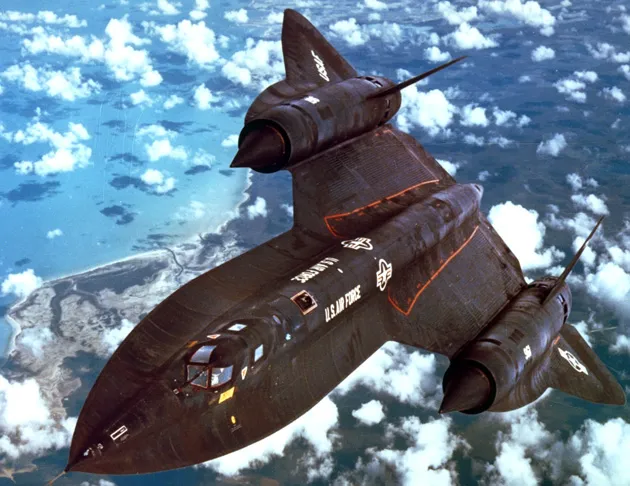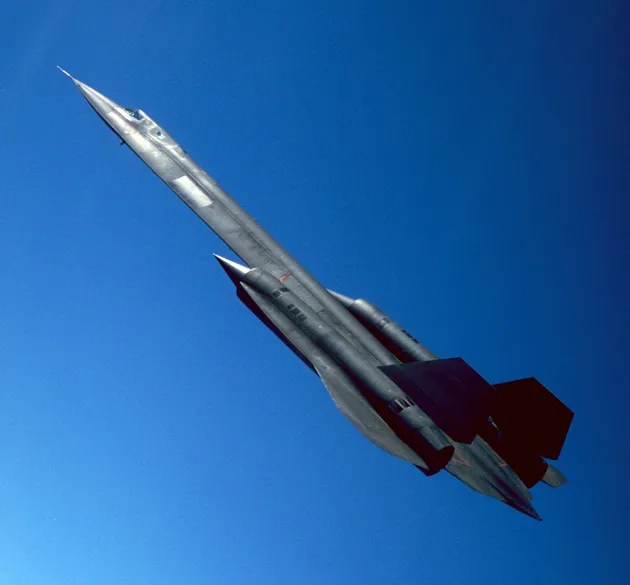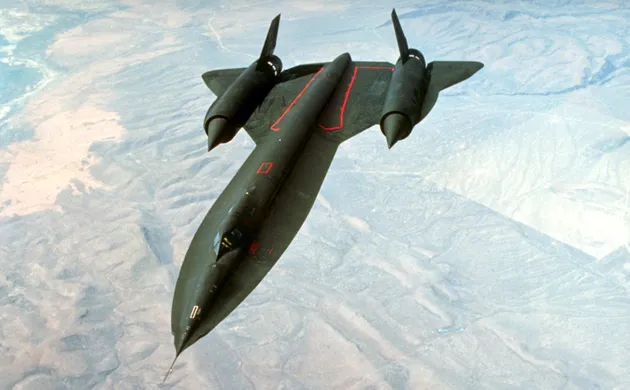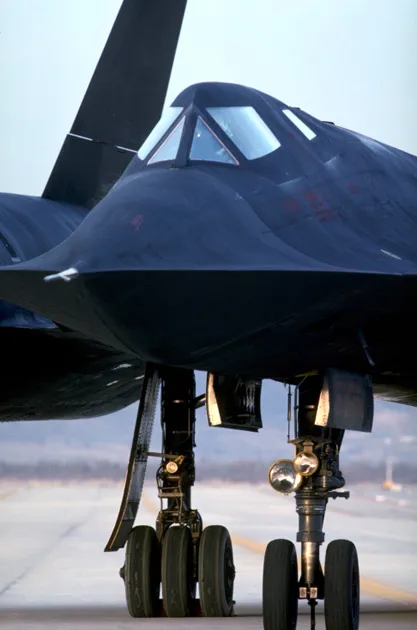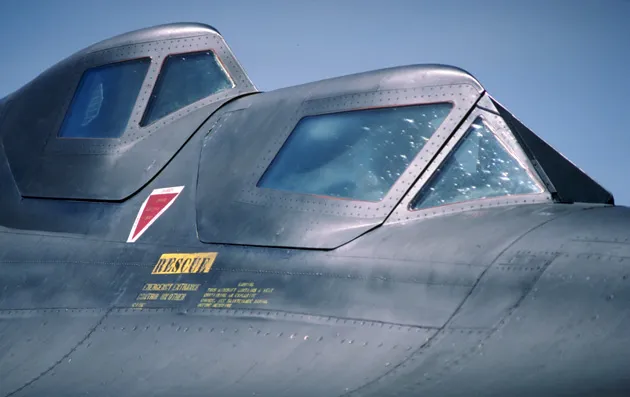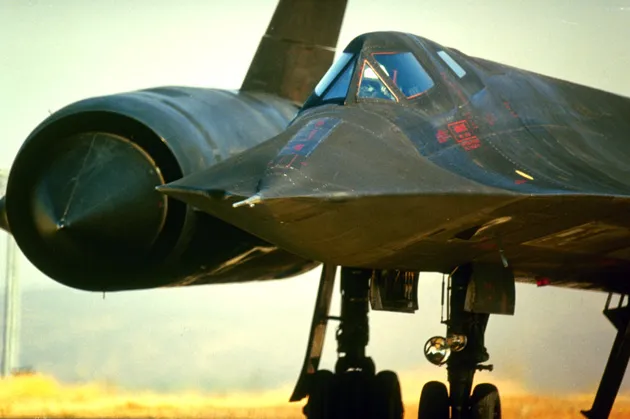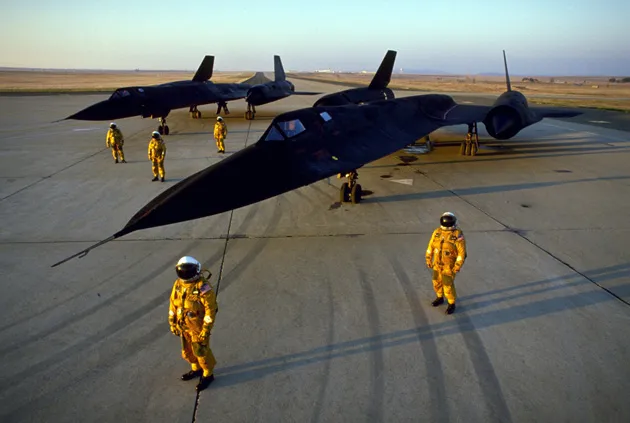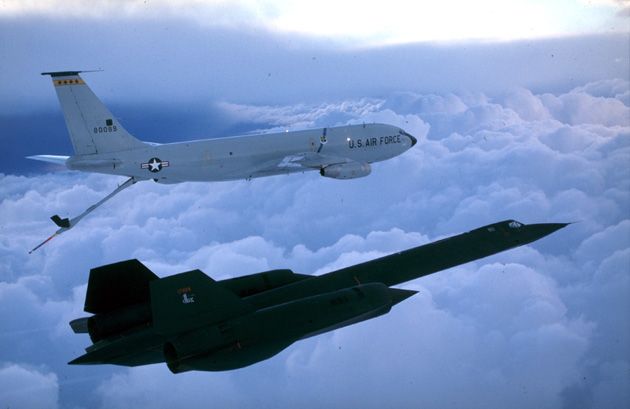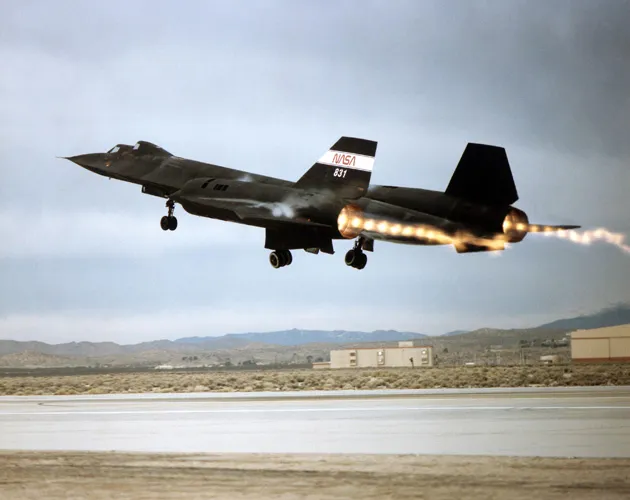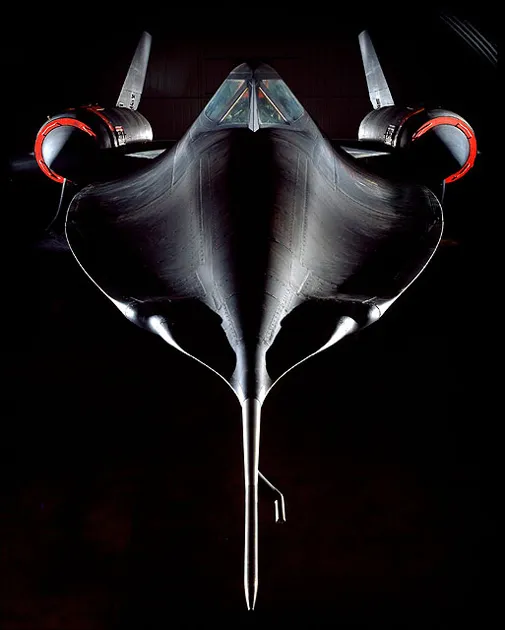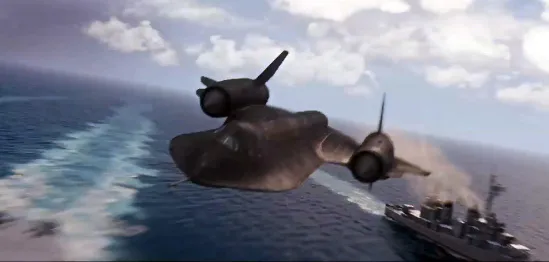The Real X-Jet
From Transformers to the X-Men, the Blackbird is still Hollywood’s favorite futuristic jet. Here’s the real story of its birth.
/https://tf-cmsv2-smithsonianmag-media.s3.amazonaws.com/filer/xjet-flash2.jpg)
On May 1, 1960, Soviet air defense missiles downed a U-2 flown by Francis Gary Powers, and, with 24 missions flown, overflights of the Soviet Union were halted. America’s first purpose-built spyplane had, until that day, avoided such a fate by flying extremely high, but the U-2 was slow, and U.S. officials had always known its days were numbered. If the airplane’s follow-on was to be less vulnerable, and assuming the high-altitude requirement persisted, as it had to, then only one area of performance remained: speed.
Under a project code-named Gusto, the Lockheed Skunk Works, headed by the legendary Kelly Johnson, and the Convair division of General Dynamics completed designs for a successor to the U-2 in the summer of 1959. Convair proposed a manned, ramjet-powered parasite reconnaissance airplane that would be launched from a special version of the B-58B Super Hustler bomber flying at Mach 2.2 above 35,000 feet. The parasite would reach Mach 4.2 and 90,000 feet, according to Convair. The project, named Fish, was terminated because the Air Force canceled the B-58B and ramjet technology was unproven. Convair later came back with the ground-launched Kingfish, based on its F-106 Delta Dart interceptor and the B-58, but it too was doomed.
That left the Skunk Works entry, which had evolved from A-1 (for “Archangel”) to A-11 and then A-12, which in turn evolved into the Air Force’s SR-71. There is disagreement even today at the Skunk Works on whether the CIA’s version was the A-11 or the A-12. Garfield J. Thomas, vice president of Reconnaissance Systems at what is now Lockheed Martin, says it was the A-11. Albert T. “Bud” Wheelon, who was head of the CIA’s Directorate of Science and Technology in the early 1960s, agrees. Engineers at Pratt & Whitney who designed its engine claim it was really the A-12. They’re all correct. Two Johnsons—Kelly in private and Lyndon Baines in public—called it the A-11. And the basic airplane was the A-11. It became the A-12 when its metal vertical tail, engine inlets, and the forward edges of its nacelles were changed to a kind of composite plastic to foil enemy radar. One thing is certain: Both aircraft were in a program code-named Oxcart. In January 1960, the Skunk Works got an order for 12.
Oxcart was to cruise at 90,000 feet and Mach 3.2—faster than a rifle bullet. At that speed, the friction of the air would create tremendous heat, but airframe heating in itself was not insurmountable. North American’s X-15 almost routinely exceeded Mach 3 and in October 1967 would set a world record of Mach 6.7. But the X-15 flew supersonically for mere minutes, not for the many hours required of a long-range reconnaissance aircraft. The F-106, the nation’s premier operational interceptor at the time and for years to come, could fly at Mach 2 for only 15 minutes at a time.
The heat that would be created by flying at Mach 3+ for long periods bedeviled engineers and required unparalleled inventiveness. As Kelly Johnson said, “Everything on the aircraft, from rivets and fluids, including materials and power-plants, had to be invented from scratch.” Long before the A-12 flew, its designers calculated that their creation’s leading edges would get hotter than a soldering iron, and without adequate cooling in the cockpit, it would literally get hot enough to bake a cake.
In early 1991, with the cold war over and much of the SR-71 declassified, the Graduate Aeronautical Laboratories at the California Institute of Technology presented a course entitled “Ael07, Case Studies in Engineering: The SR-71 Blackbird.” The course was based on a detailed three-inch-thick engineering summary, and virtually every section of the book, whether the subject was grease, hydraulic fluid, engines, oil, electrical plugs, or tires, shared one word: heat.
To cope with both altitude and heat, a fuel called JP-7 was developed with an exceptionally high flash point: A lighted cigarette tossed into a pail of JP-7 would go out. This tolerance for high temperatures allowed it to be the airplane’s primary heat sink. And there was a lot of it: The fuselage and inner wings formed fuel tanks with a capacity of 40 tons, and they were unlined, since no plastic liner could survive.
B.F. Goodrich came up with main landing gear tires that were compounded with aluminum powder to produce a silvery rubber that reflected heat from the airframe. And they were filled with nitrogen, not air, because oxygen would only incite combustion. The tires, which had a 22-ply rating, cost $2,300 apiece and were good for between 15 and 20 landings, depending on the pilot’s touch. The wheel wells into which they retracted were shielded and surrounded by tanks of fuel that performed double duty as a massive cooling system. The heat sink worked by routing the fuel to a pump that raised its pressure to 45 pounds per square inch and sent it to several valves and heat exchangers, where it cooled subsystems before being returned to the tanks to be consumed in the engines. The JP-7 circulated throughout the fuselage and wings the way blood does in animals.
A hydraulic system was invented to operate between -65 and 650 degrees Fahrenheit. After responding to an ad in a technical journal touting a fluid that would work in temperatures as high as 900 degrees, Johnson received a large canvas bag filled with white powder. He called the manufacturer and was told that it would turn to liquid when it got hot enough. The problem was solved by Penn State’s Petroleum Refining Laboratory, however, which came up with a super-refined petroleum-based oil that met the requirement.
The glass through which the all-important cameras peered had to be free of optical distortion even though the inside temperature was 150 degrees and the outside 550 degrees. (Pilots have reported that the windshield of an SR-71 gets so hot at cruise that they can’t touch their gloved hand to it for more than a couple of seconds.) That one was solved by the Corning Glass Works and Perkin-Elmer, a lens manufacturer, in three years and at a cost of $2 million. They fused quartz glass windows to the metal frame using high-frequency sound waves, which had never been done before.
The A-12 was at first provided with three camera systems that were leaps in photographic technology. Perkin-Elmer developed a stereo camera that had an 18-inch lens and a 5,000-foot film supply. This Type I camera produced paired photographs of a 71-mile-wide swatch of ground with a resolution of one foot. Roderick M. Scott, Perkin-Elmer’s resident genius, developed several innovations, including the use of a reflecting cube instead of a prism for the scanner and a concentric film supply and take-up system that minimized weight shift. Kodak created the Type II camera, also stereo, which covered a 60-mile-wide swath of territory with a 21-inch lens that resolved on the order of 17 inches. Hycon’s entry, the Type IV, was designed by James Baker and was an advanced version of his B camera for the U-2. It took seven frames that, when combined, covered a swath 41 miles wide with a ground resolution of eight inches. The Type IV also held the most film yet: 12,000 feet. Later on, a Texas Instruments infrared camera that could take pictures day or night was adapted to the A-12 and used when the need arose.
Knowing that the difference between aerodynamics and hydrodynamics was basically a matter of density—that the air in front of their aircraft would not only get hot but, in effect, thicken as the speed increased—Johnson and his team designed the A-12 to cut through very hot, dense air the way a vessel cuts through water. (The idea dates back as far as Leonardo da Vinci, who wrote that both birds and fish “fly” through different fluids in the same basic way.) That’s why the fuselage, a model of which was tested in a water-flow tank, was hull-shaped. And the forward part was stretched into what Johnson called a blended body. Its chines, when matched to a modified delta wing, dramatically increased lift at cruise speed and reduced drag significantly because it allowed the whole aircraft to create lift. The chines also formed a series of bays that were stuffed with intelligence-collecting sensors and other equipment, including electronic countermeasures.
The speed of the A-12 came from a pair of 20-foot-long engines, each weighing 6,500 pounds, that were every bit as innovative and challenging as the aircraft they propelled. That corncob of an engine was refined over the years until it developed more than 32,000 pounds of thrust, or about a third of the thrust ratings of today’s giant airline turbofans. Designed by Pratt & Whitney under tight security starting in late 1959 and designated the JT11D-20, it was developed for a Mach 3 Navy attack aircraft that was canceled by President Kennedy after the CIA convinced him that the need for a Mach-busting spyplane took precedence. It soon became better known by its military name: J-58-P2. Powerplant cognoscenti savor the J-58 as a true classic.
For security reasons, less than a dozen of the J-58’s designers knew what the whole engine looked like or was supposed to do, recalls senior project engineer Joseph A. Daley Jr. Those who did were confounded at every stage by the heat problem, just as the airframe designers at Lockheed were. “The engine operates in the most hostile environment any engine has ever been subjected to,” the Ae107 course book noted. “Air entering the compressor reaches 1,400° F. The turbine inlet temperature is 2,000° F. The temperature in the afterburner section reaches 3,200° F....”
The inlet was a particularly tough problem. Early testing showed that high inlet temperatures would hurt the efficiency of the nine-stage compressor, which, to use engineering jargon, would run out of surge margin—the engine would stall. The problem was solved in a way that gives engineers existential pleasure and evokes the word “elegant.” At the fourth compressor stage, air was bled off through six bypass tubes on the outside of the engine and routed back to the afterburner. This not only removed heat from the compressor, but caused the hot air blowing into the afterburner to arrive at the same speed as the air flowing into the inlet. The result of this was that at Mach 2, the inlet and afterburner were synchronized and therefore turned into a ramjet that provided about 80 percent of the J-58’s thrust.
The J-58 weighed more than three tons, mainly because most of it was made with Waspaloy, a nickel-based alloy that even at 1,400 degrees keeps its strength and resists oxidation. But it is also very heavy and hard to weld. The first thin sheets of the metal used for fabrication experiments were supplied by the Hamilton Watch Company. Titanium was used for the front compressor blades because it is much lighter than steel and stronger than aluminum. The forging of the blades was an art form in a titanium industry that in the late 1950s was in its infancy. Not only were the blades meticulously hollowed on the inside for cooling, but the metal’s grains were aligned for strength.
Pratt & Whitney executive Arnold J. Gunderson crystallizes the engineering challenge by pointing out that while the J-58 had parts that were machined to thousandths of an inch, the whole engine got so hot at cruise that it expanded two and a half inches in width and grew six inches in length. (The airframe expanded and contracted as well, which was why fuel leaked from its wings.) That problem was solved, says Gunderson, by putting the gear box that drives the generators, hydraulic pumps, and other subsystems on the bottom of the engine, where it effectively floats, and hanging the engine itself from the top of the nacelle so it could expand and contract without stressing its parts.
The heat also made the A-12 and the SR-71 trickier to land than to launch. Descending too quickly and shock-cooling the airframe and engines would cause a sudden shrinking of parts that could be more stressful than the expansion that occurred during heat-up. Pilots had to avoid cooling the engine at a rate that could cause shrinkage and make the ends of the turbine blades rub against their seals, ruining the engine.
Mach 3.2 was the A-12’s (and then the SR-71’s) design point. The airplane could hit Mach 3.6 and, in theory, Mach 4 if the air was cold enough. But, as Gunderson explains, “Kelly designed the airplane to fly at Mach 3.2 at 80,000 feet. The airplane cruises there. It is very, very comfortable there because that’s the point at which it was designed to fly, where every system is snug and tight-fitting.... All of the enhancements and refinements we did over the many, many years of the program were done to reinforce that. Moving away created more problems than it was worth. Every time we flew faster and higher, we ran into areas where we had not so much experience. Things would go wrong. You’d swallow the [aero]spikes, you’d flame out.”
Unlike their engines, 93 percent of the airplanes’ structure and skin were made of titanium. The metal’s quality varies widely, and the first batch of titanium sponge (which looks like a giant soap pad) had to be bought by the CIA from the Soviet Union and smuggled past U.S. Customs. Ironically, the Soviets had most of the world’s supply of the metal and exported a product of exceptionally high quality. The plane’s landing gear was the largest titanium forging produced in the United States and the only titanium landing gear in use in any U.S. aircraft. Forging and cutting special metals to tolerances as tight as .005 inch, then welding them together, were exotic specialties that were virtually developed from scratch.
Welding brought with it new mysteries. Skunk Works engineers were at a loss to explain why A-12 wing panels that were spot-welded in the summer failed early, while those that were welded in the winter held together indefinitely. They traced the trouble to a characteristic of titanium: It is absolutely incompatible with chlorine. “We finally traced the problem to the Burbank water system, which had heavily chlorinated water in the summer to prevent algae growth, but not in winter,” Johnson related in a classified CIA journal article in 1982. “Changing to distilled water to wash the parts solved the problem.”
The A-12’s inlets, which include forward air bypass doors that automatically manipulate the air—and the famous spikes—were designed under Lockheed engineer (and later Skunk Works president) Ben Rich’s supervision and are the key to the airplane’s performance. The B-58 Hustler bomber used fixed spikes in front of its General Electric J-79s. Like his counterparts at Convair, Rich found that air hitting the unprotected front of a turbojet at high Mach numbers creates insurmountable pressure problems.
The spike’s purpose was to control the supersonic shock wave and, by working in combination with doors and openings to bleed away excess air, prevent supersonic airflow from entering the compressor intake. It accomplished this trick by moving back 26 inches into the throat of the inlet on a programmed schedule as the speed built up in a manner somewhat like the way the nozzle on a garden hose changes to adjust the water’s flow. At Mach 3.2, each inlet swallowed about 100,000 cubic feet of air a second.
When a spike failed to work perfectly, which happened repeatedly for many years, supersonic air pressure instantly built up and choked the compressors. They reacted without warning by violently spitting the shock wave back out. This event was the dreaded “unstart,” which, at Mach 2 or higher, would cause a thunderous bang that the crew heard and felt, while the airplane jerked so violently in the direction of the unstarted inlet that, according to Lockheed Martin’s Garfield Thomas, “it was like running into a brick wall.” He remembers one unstart yaw violent enough that the pilot “slammed his head so hard against the sill on the window [that it] cracked the helmet and knocked him semi-conscious.” A computer restarted the inlet, Thomas adds, and the pilot survived.
Blair L. Bozek, a reconnaissance systems officer with extensive experience with SR71s, says an unstart at Mach 3.2 “is like driving on the highway fast, taking an off ramp, hitting black ice, and having your car slam into the guard rail.” Justin Murphy, SR-71 program manager at the Skunk Works, remembers that “the way you knew which side the unstart was on was which side of your head hurt.” Bud Wheelon observed that Lockheed test pilots were “remarkable in their ability to delay normal human emotional reactions to chaos. In Area 51 [the flight test area at Groom Lake, Nevada], I’ve talked to them on the radio. They were calm as can be and very clinical, until they came down. And then they’d start weeping.”
The problem in the early days, says Wheelon, was that the hydraulic servo that moved the spike reacted too slowly to changes in Mach number. He told Johnson that hydraulic fluid can only move so fast; it has friction and inertia, and he began to advocate that the spikes be moved electrically.
“What you have to know about Kelly Johnson is that he’s everything everybody says he is,” Wheelon explains, still using the present tense more than six years after Johnson’s death at the age of 80. “He’s a wonderful guy. But he’s a stubborn son of a bitch to boot. And Kelly did not trust electronics.” Johnson also knew that electronic systems did not fare well in an engine that got as hot as the J-58 did.
“We’ve got $30 million invested in this servo,” Wheelon quotes Johnson as saying, “and we can’t just run a truck over it.”
“Every time we crack up an airplane we spend that much money. And we’re killing people,” Wheelon says. Of the initial group of 18 F- and A-12s, seven had been lost with at least two fatalities, though not all instances were attributable to the servo. Losses of SR-71s continued during the mid-1960s.
But Johnson was absolutely adamant: “I’m not going to have electronics in the airplane.”
“Kelly,” Wheelon recalls responding, “you’re the world’s greatest aeronautical engineer. But this program is going to stop unless you put an electronic servo on that thing. Now take your pick.”
Wheelon says that Johnson went to Washington, apparently to go to someone in the agency over Wheelon’s head. When he came back he told Wheelon that he had decided to go to the electric servo. But that may have been sheer guile, because hydraulic actuators are still used in the few SR-71s still flying. The number of unstarts was greatly reduced when the system’s analog computers were replaced in 1983 by far faster and more sensitive digital ones as a result of the development of a Digital Automatic Flight and Inlet Control System. The DAFICS computer, working closely with the spikes and other inlet components, reverses unstarts in fractions of a second.
Pratt & Whitney’s Arnold Gunderson has thought a lot about his supremely powerful but high-strung engine. The J-58 is complex, and each of its systems is coupled in some obscure way with other systems, which meant that all these relationships had to be learned.
“Every time you make an improvement, you’ve ruined or degraded something else,” Gunderson observes. “If you optimize something here, you’ve made it significantly less optimal somewhere else. Now, you’ve got an engine, which is a highly complex thing, with its own internal subsystems. You’ve got a completely self-contained afterburner control system, a self-contained main engine control system. You’ve got the spike going back and forth along its 26-inch path. You’ve got the four bypass doors that regulate the static pressure inside the duct. When they’re closed, it’s maximum ram recovery. When they’re open, you create drag. All of these things affect the entire propulsion system. Now, that’s just the main features.... Every time we made a minor change in how the engine worked,” he adds, “it had to go back into an integrated engineering approach with the entire propulsion system.”
The problems plaguing the engine in the beginning caused delays of months and would have financially broken the program had the Navy not bailed it out with $38 million. Every serious problem that afflicted the J-58 was given a number, and the list eventually reached more than 270. “ENC—Exhaust Nozzle Control instability—was problem number 6,” Gunderson says. “It was still an active problem in 1974. Even then we were trying to figure ways to keep the engine stable. As you can imagine, it goes back a long, long way.”
Some J-58s, like a couple of the airplanes they powered, absolutely refused to work properly no matter what was done to them. Gunderson says that any J-58 whose parts were fundamentally unhappy with one another for no apparent reason was disassembled and their parts saved to repair other engines.
The SR-71s also had marked differences. Thomas maintains that each Blackbird had a distinct personality and that careful records documented them as clearly as diary entries. “I could tell you something different about each one of those airplanes,” he says. Number 974, which perished in the South China Sea near Luzon after a catastrophic engine failure, gave its crews all it had. Justin Murphy agrees, and says the same about 971. Author and former SR-71 pilot Richard Graham swears that 962 “never let us down.” But 959 was a hangar queen, an absolute “lemon,” according to Thomas. “You could never get everything to work at the same time. The Air Force said, ‘Come and get it. We don’t want it.’ ” There were also problems with the defensive system, but they were philosophical, not technical. Johnson believed so strongly that his supersonic spyplanes would be adequately protected above 80,000 feet at Mach 3.2 that he vigorously resisted equipping them with electronic countermeasures.
Wheelon recalls that he tangled with the always weight-conscious Johnson over ECM too. Wheelon won, and as a result, the A-12 and SR-71 were equipped with the newest defensive systems.
And the opposition never gave up the notion of trying to bag one, as it had Francis Gary Powers’ U-2. He can’t recall the precise designation but Gunderson remembers a Soviet missile that had the theoretical capability of flying up in front of an SR-71, then plunging down and hitting it at Mach 6—a nearly impossible feat because there was almost no warning that the airplane was coming. Still, there was always the possibility that one would get hit by a “golden BB.”
It was certainly in the back of the Air Force’s collective mind. The airmen were concerned that if the airplane went down carrying ECM hardware all of the fighters and bombers that carried the same equipment would be compromised. Yet not installing it could have hastened the day when one of the high fliers was shot down.
While the U-2 was given a very simple ECM system, says Thomas, the SR-71’s electronic bays were crammed. All of the ECM equipment, plus the SR-71’s nose-mounted high-resolution optical bar camera and its side-looking radar and other sensors, were operated by the reconnaissance systems officer, or RSO, who sat behind the pilot. The CIA’s A-12 had one pilot who ran everything, but the Air Force decided that the load was too great, so it had the Skunk Works make room for the RSO.
That change and others created real differences in both airplanes’ performances. The A-12 actually flew up to 5,000 feet higher than the SR-71, was a bit faster, and had cameras that could cover three times as much territory with better resolution. The penalty for adding a crewman was a smaller camera. “The A-12 was like the U-2,” says Bob Murphy, the SR-71 plant manager. “It had a massive camera, a very, very large camera, whereas in the SR-71, the second guy sits where the massive [Type I] camera went in the A-12.”
Whatever its limitations relative to the A-12’s camera, the SR-71’s was by all accounts good enough. According to Ben Rich, it could peer more than 130 miles into a targeted territory. It is still used on U-2s and remains classified. The SR-71’s performance was also somewhat reduced by the side-looking radar it carried, plus gear that collected electronic and communication intelligence by sniffing out radars and listening to radio transmissions.
The CIA’s contract for the A-12 specified that it have very-low-observable qualities but not that it be completely stealthy. Still, the low-observable specification was a problem that had to be solved before the contract was finally signed in February 1960. Its blended body reduced its radar reflectivity dramatically. Its overall shape, including the two vertical tails that cant inward plus lots of curves, helped to hide it. So did special radar-absorbing plastic panels made of silicone and asbestos that had to be formulated to withstand temperatures of roughly 550 degrees.
What was more difficult, according to Thomas, was shaping the surfaces so that they intercepted, captured, and absorbed or redirected radar signals. The trick was to guide the radar signal around the aircraft before either dissipating it or redirecting it. He describes the plastic panels as a series of gradually phased “steps” that accomplished this with exquisite nuance. “An enormous amount of invention had to go into this thing,” Thomas says, “and it was all done simultaneously in a matter of 31 months.” And, as almost everyone who was involved likes to point out, nearly all the engineering was done with slide rules and calculators rather than computers.
Besides creative genius, Kelly Johnson had an aggressive and practical business sense. When he thought up the A-12, he saw the airframe as the equivalent of a basic automobile chassis that could be assembled as a sedan, a convertible, or a station wagon. The key was to use different forward fuselages on the same basic body, wing, and tail. The separation point was at Frame 715, which connected the wings at the roots of their leading edges. Everything behind 715, including the nacelles and their inlets and engines, remained essentially the same while the forward fuselages differed. The basic design was therefore turned into a long-range missile toting interceptor called the YF-12. Another version, the M-12, carried a ramjet-powered, camera-carrying drone called the D-21 on its back. “M” stood for mother; “D” for daughter. The thing was used briefly over China with mixed results and one of the D-21s destroyed the M-12 that carried it when it slammed into the aircraft during separation.
There were even plans that never materialized for a penetrator version that could have carried nuclear missiles. Pratt & Whitney’s Joseph Daley says that the Soviets at the Strategic Arms Limitation Talks in the late 1960s insisted that it not be built because “if it was used offensively, there was no way in the world you could defend against it.”
And there was yet another permutation—a bizarre one. SR-71 lore has it that the airplane was really designated RS, for Reconnaissance Strike, but that President Johnson mistakenly called it the SR when he announced it in 1964; the name stuck and it became Strategic Reconnaissance.
In fact, the SR-71’s stated mission when it was created was not to collect routine intelligence but to do “post-strike reconnaissance” a few days after World War III began. With air bases and much of the United States reduced to radioactive rubble, the Pentagon’s war planners would have wanted to locate Soviet targets that were still standing, according to Daley, as part of the ultra-secret Single Integrated Operating Plan by which the war was supposed to have been fought.
The Strangelovian plan called for moving two SR-71s and a C-141 transport full of support equipment and photo-interpreters to remote bases like Mozambique or Diego Garcia. With the first missile and bomber exchanges over, the SR-71s would scour the U.S.S.R. for remaining targets and get the information to the Navy’s missile submarines so they could continue the ballistic beating. The pilots would have been provided with eye patches, Daley adds, “so when the things [submarine-launched missiles] go off, you still have one eye that can see.” With what remained of the 15 A-12s mothballed, and with World War III averted, the 31 expensive SR-71s were put on regular reconnaissance duty until they were finally retired in January 1990, only to be revived in on-again, off-again directives from Congress.
And to show that the aircraft was infinitely flexible, there was a version that could go to orbit, at least in the imagination of a whimsical engineer at the Skunk Works. Included in the Caltech Ael07 course book was an image of an SR-71 bolted to a shuttle external tank containing JP-7 and two solid rocket boosters. No air-breather can reach space, of course, but it certainly captured the spirit of the enterprise.
Tough Customer
Going Mach 3 wasn’t Johnson’s only problem. Another was his customer, the Air Force itself. General Curtis E. LeMay, the stogie-chomping head of the Strategic Air Command, didn’t like specialty items like the U-2, A-12, and SR-71. It was he who coined the term “boutique” for units that flew Lockheed’s handmade spyplanes. LeMay believed in collecting intelligence, but he didn’t want reconnaissance to come out of his budget, and he worried that such elite units would distract his workaday bomber crews. To LeMay, boutique aircraft were pricey, finicky, hard-to-maintain, limited-edition peacocks flown by “prima donnas” (as he put it). What he wanted, first and foremost, was the Air Force’s bread and butter: bombers and ballistic missiles that could go to war, not “odd-balls” (as he also put it).
LeMay spoke for himself. But while the Air Force readily bought and used SR-71s, his words haunted the 9th Strategic Reconnaissance Wing at Beale Air Force Base in California, which operated them. Blackbird crews tended to feel like they were in an orphanage. Colonel Richard H. Graham, an SR-71 pilot, wrote, “The SR-71 never had a legitimate place in SAC—our entire program was always considered their step-child.” Justin Murphy, the Skunk Works SR-71 most recent program manager, couldn’t agree more. “Sure, we were a wonderful thing to have for airshows,” the former SR-71 pilot says. “We didn’t fly with nukes, we weren’t a bomber, we were kind of just out there.”
